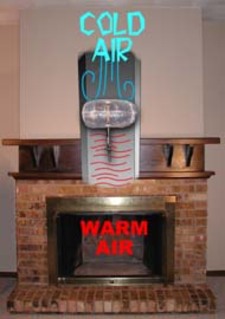
by blogediter | Jun 1, 2018 | Chimney Problems
OLYMPUS DIGITAL CAMERA
This is a story from a Chimney Balloon customer that talked about their Chimney Balloon and how it solved their leaky & stinky chimney problem on Google Home Improvement groups.
Below was the resolution to their problem:
Hello, I just thought I’d post an update and the conclusion of my fireplace saga, in case it’s of use to the next person looking for fireplace help.
First, we called the fireplace guys back, who said the old damper maybe wasn’t working after all and also found more suicidal squirrels. They removed them and installed a new damper cage.
There was no improvement with the draft, only it was more smoke and less foul. We were considering our options and we’re going to call and give the chimney guys hell.
We decided to get one of those chimney pillows as a temporary stopgap until we could get the problem solved once and for all. In the meantime, we noticed that bricks on both shoulders of the fireplace were loose and there was lots of cracked mortar and moss. There was no direct evidence that this was causing the draft – no air coming out, the lining was intact under the bricks, that we could see at any rate. But it was clear that this was only going to get worse if water and plant life kept getting in and we didn’t want bricks to start falling off the chimney.
So hubby bought a chimney pillow and some sort of masonry cement caulk
and glued the loose bricks and filled in the large cracks.
Instant cure. We weren’t even trying to fix the draft problem, and I still don’t know exactly where the leak was coming from, but this fixed it. We still get some smell when the heat or certain fans are on, but that’s expected. The Chimney Balloon will fix probably that.
MK
This was the initial posting of their fireplace problem:
Hi
Good morning,
I am having an ongoing fireplace saga that I am hoping the good folks here can help me with. We just bought a townhouse this fall, built in 1973, with a fireplace. To make a long story short, here’s the timeline of what’s been going on.
The fireplace was sealed (opening covered in plastic wrap) when we bought the house. We unsealed it. Fire burns fine, but the smoke smell and strong draft pour in when not in use.
Did some research, found out about negative pressure – the house seals like Tupperware so this makes a lot of sense for us. We opened a window in the basement next to the furnace. No change.
Brought in a professional to do the sweep/inspection that we should have done in the first place. He cleans out the chimney, fixes the damper that was apparently never closing, removes an interred squirrel of great antiquity. He also replaces the crown and says water has been leaking in and causing mold for a long time.
The draft problem is now completely fixed, but the strong smell still fills the living room and creeps around the house from there – a foul, wet, moldy-sooty smell.
So I see two angles here. One is trying to improve the condition that is still causing the fireplace air to come in. The other is dealing with the nasty smell in the fireplace. But this is so far out of my realm of experience, I am not sure. I don’t mind a little soot smell, I understand that’s part of owning a fireplace, but you can’t stay in that room and breathe without opening a window.
What should we do? Will a steady regiment of fires and ventilation improve things over time? Is there something more drastic we will need to do? Is there something that might kill the mold we suspect is up there? We think the fireplace may have been sealed from the inside but exposed and leaking to the outside for the 12 years the previous owners lived here. Is there an air-tight plastic cover or something we could fit over it when not in use?
Any help would greatly be appreciated.- MK
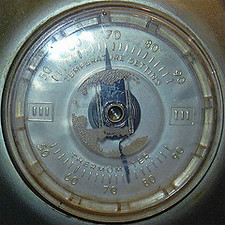
by blogediter | May 30, 2018 | Save Energy
Thermostat dial
Q: Jason – My home is mostly closed right now due to the heat of the summer and the cost of electricity to run the air conditioning. I am doing the simple steps to save money on my air conditioning, but what about air quality? I am essentially recycling air in my home just like in the winter. – TY
A: TY – You are absolutely correct. It doesn’t matter if it is winter or summer if you have your windows closed and the air or heater on…you are recycling air and it could be low quality air.
The US EPA says the most energy efficient and cost and the energy friendly way to deal with stale air is “Source Control” of indoor pollutants. This essentially means you need to stop doing things that contaminate your indoor air.
Here are 4 steps to help you with this issue.
Step 1: Plug the bad air intake spots. Your house is going to tend to suck in air because of the negative pressure created by fans, AC, furnaces, wood or corn burners, or other sources. In the winter time, this is more noticeable because this inward pressure manifests itself as cold drafts that are easy to identify. In the summer warm drafts are tougher to spot. Plug up the worst bad air intake spot in your home: the fireplace chimney. The chimney acts as a filthy snorkel as it is often the path of least resistance for air to enter your home. Imagine breathing in through a creosote and ash filled snorkel and you will see why it is important to plug this air entry point airtight. Closing the damper is a good start but a Chimney Balloon will help you get the tight seal that you really need to keep your home from taking in air through this path.
Step 2: If you are doing an indoor home improvement project that includes painting, sanding, torches, welding, soldering, burning, heat gunning, harsh cleansers like Bleach or Ammonia, or any other activity that puts something into the air other than your breath…you will be better served to open your home to the outside than to keep it closed up. At a minimum, open up the room you are working in to air it out. If you don’t, your return vents suck this in and circulate it through your house repeatedly.
Step 3: Display your nice paraffin or scented candles but don’t burn them. Anything you burn from candles to wood in the fireplace is going to introduce toxins into your air through smoke and carbon. There are some friendlier Soy-based candles that are not nearly as polluting as regular scented candles, but they should be used with a trimmed wick so the flame does not get too long. This probably goes without saying but smoking cigarettes and pipe in the house is horrible for everyone in the home, especially when the house is closed.
Step 4: Don’t bother with tabletop air purifiers or ridiculous amounts of houseplants. The US EPA does not certify or endorse air cleaning filters. And third-party testing labs like Consumer Reports do not give glowing reviews of any air filter products. As a matter of fact, they have found some filter systems tend to introduce more ozone than is healthy. And the US EPA says the small amount of plants helps with carbon dioxide levels but does nothing for air pollutants. Too many moist plants can cause mold issues. When it comes to air filters and plants it is best to focus your energy on other ways to make a dent in indoor pollutants.
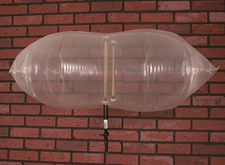
by blogediter | May 28, 2018 | Chimney Plugs
Chimney Balloon Double Construction
Q: Jason – Can you make a Chimney Balloon with the inflator valve off center? My Chimney flue leads into a larger area that won’t allow a centered valve. – CC
A: CC – We can absolutely make your Chimney Balloon with the inflator valve off center. When you place your order for the Chimney Balloon followup with an email that says how many inches off center you need the inflator valve on the Chimney Balloon. attached to this posting is a picture of what a Chimney Balloon looks like with the handle valve off center. This photo is shot from a side angle so you have to look close to see that there is another retaining band inside the Chimney Balloon further back, and the handle/inflator valve is actually forward in the picture. Keep in mind that this type of Chimney Balloon is a custom Chimney Balloon. Therefore it takes up to 14 days to ship. – Jason
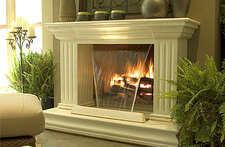
by blogediter | May 24, 2018 | Fireplaces
Hearth Falls
When I first heard of the Fireplace waterfalls on Fireplace Lowdown Blog I knew I had to write something on these beautiful living room pieces of art.
Unfortunately, it has come to our attention through this blog article that Hearth Falls has had some serious issues. If you have experienced these issues you are welcome to contact Duayne at the Attorney Generals Office in Littlerock, Arkansas. They apparently are handling this case.
A photo is provided by Hearthfalls.com. Copyright ownership belongs to Hearthfalls.com
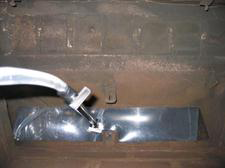
by blogediter | May 23, 2018 | Chimney Plugs
Chimney Balloon Flue Cable
Q: Jason – Can I install a Chimney Balloon just above my fireplace damper opening if I have a cable going through the flue up to the chimney top lymance damper? Right above the damper, the cable is about 3″ away from the wall of the flue. The trouble I am having with my current damper is the fireplace is smelly and it stinks like the campfire all the time, even when I haven’t had a fire for months. – GJ
A: GJ, Yes it is possible to install a Chimney Balloon with a lock-top cable on the side of the flue. The Chimney Balloon will wrap around the cable as it inflates, but it takes some planning to apply the Chimney Balloon properly. Here are 3 steps to keep in mind.
Step 1) When you measure above your flue buy a Chimney Balloon that is a little oversized. For Example, If the cable is 3 inches away from the side of the flue buy a Chimney Balloon that is 3″ too big in both width and length.
Step 2) Carefully, feel the cable before you install the Chimney Balloon. It may be sharp so be careful. If it feels frayed or pokey or flat on one edge then you will have to wrap it with some tape to protect the Chimney Balloon. If you don’t, the cable will poke or cut into the Chimney Balloon as it envelopes the cable, since that tight cable can cut like a knife.
Step 3) DO NOT open and close your lock top damper with the Chimney Balloon in place. If you do this the cable will saw into the Chimney Balloon.
The picture above is a photo of a customers damper with a Chimney Balloon that has a cable for a lock-top (you can see the cable on the lower left side of the picture.)




